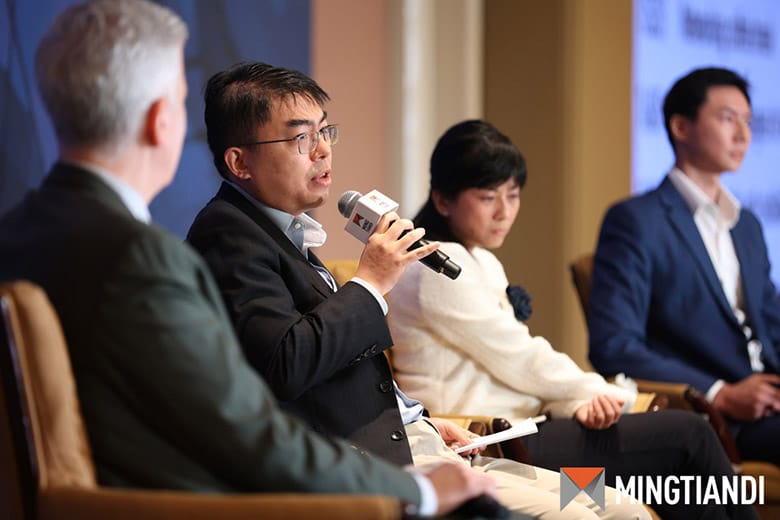Warburg Pincus, BW and NWP Report Strong Industrial Markets in Vietnam, Indonesia
Supply chain shifts are presenting opportunities in Southeast Asian logistics properties as manufacturing and consumption growth drive demand for sheds, factories, and logistics properties, according to a panel of top executives speaking at Mingtiandi’s second Singapore Focus Forum on Tuesday.
Vietnam and Indonesia’s industrial property markets are following a growth model similar to more developed Asian economies like China, Korea, and Singapore, according to Fan Li, a partner at Warburg Pincus in Singapore, who sees improved infrastructure and rising foreign direct investment, as well as geopolitical dynamics, accelerating the supply chain migration from North Asia to Southeast Asia.
“They (manufacturers) are in a much tighter supply chain today in that they are required to put up their operations as soon as possible, which actually plays very well into how we play, which is renting and providing institutional service for these manufacturers,” said Fan, who played a key role in the development of industrial giant ESR over a decade ago. “There is a very strong desire for market participants to meaningfully upgrade supply chains there.”
Li was joined on-stage by Fion Ng, chief operating officer of Ho Chi Minh City-based BW Industrial, and Kevin Kow, chief executive officer of Jakarta-based NWP Property. Both companies are backed by Warburg Pincus.
Vietnam Manufacturing Boom
Global supply chain diversification, increased foreign direct investment, and a booming manufacturing sector have boosted demand for factories and warehouses like those developed by BW Industrial, which bills itself as Vietnam’s largest and fastest-growing pure-play industrial developer with over 40 projects in more than 30 locations.

Fan Li of Warburg speaking at the Mingtiandi Singapore Forum
“When we talk to our customers, they tell us supply chain diversification remains a top priority. For us on the ground, being the largest for-rent logistics as well as industrial real estate platform, we experienced a significant increase of 75 percent in leasing inquiries year to date,” said Ng. “We continue to see very strong demand despite the softening of the export orders that we all hear about. That has led to very good occupancy on the ground – occupancy of nearly 95 percent for our stabilised assets.”
Established as a joint venture between Manhattan-based Warburg Pincus and Vietnamese state-owned builder Becamex IDC Corp in 2018, the company currently has a land bank of over 8.5 million square metres and 3.1 million square metres of gross floor area in operation or under development. The company has established relationships with over 270 tenants from more than 20 countries, most of which are in the e-commerce, last-mile delivery, or high-tech manufacturing sectors.
In January, Hong Kong-listed industrial real estate fund manager and developer ESR took a strategic stake as the lead strategic investor as part of a primary fundraising round of up to approximately US$450 million that also included other leading investors in Asia.
Ng, who previously headed Southeast Asia investment and development at ESR and investments at Mapletree Logistics, sees sustained demand for industrial properties driven by surging foreign direct investment and Vietnam’s booming manufacturing sector.
“We continue to see very strong FDI inflow. Year to date we are talking about a nearly 15 percent increase in total registered FDI for Vietnam. That’s the most important part of our business because FDI drives demand for industrial space as well as logistics space. On the back of this surging demand, we are on track to deliver 10 new projects totaling 1 million square metres this year,” said Ng. “This year, the star performer is the manufacturing sector. We see that supply chain diversification continuing beyond this year into the next couple of years.”
Betting on Indonesia Consumption
For NWP Property’s Kow, Indonesia’s consumption-oriented economy has created an entry point into the logistics sector.
“Indonesia remains one of the greatest consumption stories in the world. It’s a $1.2 trillion USD economy, and the country’s consumption as a percentage of GDP has consistently been about 55-60 percent” said Kow. “We are focused on consumption infrastructure – that’s retail and logistics.”
Established in 2015 as a joint venture between Warburg Pincus and Indonesian developer PT City Retail Developments Tbk, NWP Property has grown from four seed projects to over 50 developments spanning more than 1 million square metres of gross floor area.
NWP Property changed its name from NWP Retail in 2022 as the developer broadened its mission by addressing an undersupply of modern warehouses in Indonesia’s logistics market. The company launched a joint venture with a Japanese warehouse developer in March of last year to establish a logistics platform seeded with a pre-leased, build-to-suit warehouse project in Jakarta.
With the Indonesian logistics sector still in an early development stage, Kow expects an eventual decline in logistics costs, as well as increased demand for modern logistics properties, to support demand going forward.
“The logistics costs in Indonesia are extremely high – it’s around 25 percent of GDP, compared to around 15 percent in other developing markets like Thailand and China and high single digits for developed markets like Singapore, Hong Kong, and Japan. The trend towards lowering of logistics costs will create a stronger demand for tenants, for users who are requiring more efficient spaces, more modern types of logistics facilities,” said Kow.
In the longer term, Kow predicts that the Indonesian market will continue to grow in a direction similar to that of other Asian economies, creating more demand for the company’s facilities.
“We see that the logistics market will grow and mature,” Kow said. “Tenants and customers will demand more efficiency, and we want to place ourselves in the midst of that transition.”
